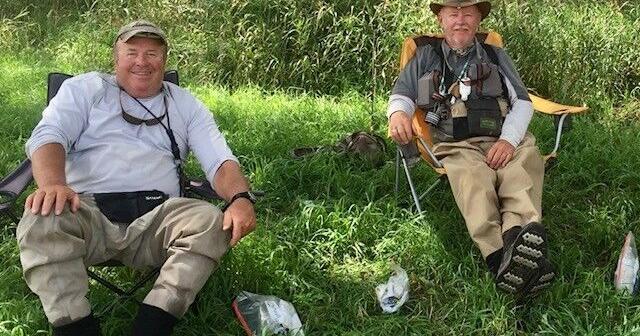What Lancaster County service club has more than 800 members and has finagled more than $6.5 million in grants over the past 54 years to remove pollution and bring back wild trout in more than 17 miles on a dozen streams?
The Donegal Chapter of Trout Unlimited, probably the busiest and most productive grassroots club you’ve never heard of.
Recently, one of the county’s most successful conservation groups accepted the award for being Pennsylvania’s best Trout Unlimited chapter — out of 52 — for 2021. It was the second time the club has been so honored since its founding in the basement of Mount Joy’s Ken Depoe in 1967.
Started initially as a fly-fishing club for students by Depoe, 93, a retired graphic arts teacher at Donegal High School, the chapter started becoming much more than that with the arrival of Bob Kutz, of East Hempfield Township, and Greg Wilson, of Lititz, who died Thursday morning at 62 from complications from COVID-19.
The club’s initial push was to get the Pennsylvania Fish and Boat Commission to create two fly-fishing-only, catch-and-release stream sections in Lancaster County. They did.
Then, the fledgling club wanted to do more to give back to the streams that gave them so much pleasure. But, as Kutz tells it, “We didn’t know what we were doing and we didn’t have any money.”
Then Wilson joined. A workhorse extraordinaire, Wilson quipped to Kutz one day, “You find the money and I’ll spend it.”
Why, Wilson thought out loud, should he be driving all over the state to find prime trout fishing when there were streams that could offer that in Lancaster County?
They started by taking $300 in dues and did a modest initial project to improve Lititz Run, a stream blessed with natural spring water but cursed with pollution. Twenty years and more than $1 million later, the Lititz Run restoration has won national awards and the stream supports wild, reproducing brown and rainbow trout.
Kutz, who owned his own business, learned the ropes and became quite adept at attracting state, federal and local grants to support local cold-water stream restoration. Wilson, who owned a concrete business, became proficient at twisting the arms of local contractors to supply free or bargain-priced backhoes and operators, and lining up volunteers to do the dirty work. He was always in the mud himself, doing grunt work on projects.
Together, they became a dynamo team, one by one cleaning up promising but impaired cold-water waterways around the county. The winning formula involved stopping erosion and the flow of farm runoff into streams while creating fish habitat at the same time. Then vegetation is planted along the stream for shade and to filter runoff.
“We just fed off one another,” says Kutz. “We just kept the ball rolling and rolling and rolling.”
In 2021, the chapter created its first annual conservation award for county residents. Kutz and Wilson, who have devoted more than 35 years to the cause, were the first to be given the award.
At first, the chapter held fundraising banquets to help finance the smaller projects. But Kutz, now 80 and still reeling in grants, began attracting bigger fish.
The chapter’s work was so successful and high quality that the state Department of Environmental Protection came to the group and asked if they would take charge of doing larger cleanups to remove targeted streams from being on the state’s list of impaired waters. With Lancaster County having more miles of impaired streams than any other, there were plenty of possible projects.
Money from DEP and the federal Environmental Protection Agency for restoration of the Chesapeake Bay began rolling in. Since 2006, substantial work has focused on Conowingo Creek in the county’s southern end. It continues today.
Other streams that have had sections restored include Fishing Creek, Big Beaver Creek, Segloch Run, Furnace Run, Swarr Run, Jackson Run, Charles Run, Bowery Run and Climbers Run.
All are streams that hold wild trout or ones the chapter knows could hold them with proper doctoring.
This spring, improvements will be made to Peters Creek, which was targeted because it has one of the last-known populations of the threatened Chesapeake logperch.
The work is not always on the water. Getting financial aid and technical guidance to farmers to prevent runoff from reaching the stream can be just as important. Things like putting a gutter on a barn to keep rainwater from collecting manure and flowing into a stream.
Donegal TU also will be a critical partner in a major new state initiative to restore the upper reaches of Hammer Creek to bring back trout and keep Speedwell Forge Lake from again filling up with sediment from upstream agriculture.
As the all-volunteer chapter’s success stories grew, membership has climbed to become the state’s second largest, its 885 members exceeded only by a Pittsburgh-area chapter.
Today, many of the chapter’s members are families and people who don’t even fly-fish but want to roll up their sleeves and open their wallets to support local cold-water conservation.
Lydia Martin of Conestoga was moved by what she saw in Donegal TU’s restoration of Climbers Run on property owned by the Lancaster Conservancy.
“I was excited that someone was looking at cold-water resources. I felt like there was a lot of focus on land but not aquatic insects,” she recalls. “I get really excited about being a part of an effort that is homegrown. Not everyone enters the chapter through the lens of ‘this is how to fly-fish.’”
Now, Martin is the chapter’s communications director as well as a board member and is credited with growing membership to record levels.
Martin also cites the chapter’s deliberate efforts to be more inclusive, attracting more women, people from diverse and underserved communities and local students.
It supports a statewide program called Stream Girls that uses women to introduce female youths to both fly-fishing and scientific appreciation of streams. Girl Scouts can earn merit badges under it. Under the Trout in the Classroom program, students from more than two dozen local schools grow trout from fingerlings in their classrooms, and then release them in local streams.
Four of the chapter’s seven board members are women.
The club certainly hasn’t forgotten its fly-fishing roots. Free instruction for fly-fishing and fly-tying are held periodically. And most members know how to match the hatch and tie their own flies.
But it has become much, much more, to the benefit of Lancaster County. The club recently joined Lancaster Clean Water Partners, a countywide collaborative partnership of diverse organizations with a goal of having Lancaster County’s water flowing clean and clear by 2040.
The club has helped launch a handful of grassroots watershed groups around the county, including one made up of Plain Sect farmers.
“We decided we did not just want to be a fishing organization,” says past president Barry Witmer, who helps run the group’s native tree nursery at the Millport Conservancy near Lititz to supply riparian buffer projects.
He welcomes individuals or families with no interest in fishing to come forward to volunteer for a stream planting or join the newly created Water Quality Volunteer Coalition which trains everyday people to become citizen scientists and test and monitor local stream sections.
“It’s not a fishing club,” emphasizes Kutz. “We’re more of a conservation outfit than anything else.”
This is how Witmer sums up what the Donegal Chapter of Trout Unlimited has become: “It’s about neighbors getting together to help neighbors.”
Ad Crable is an LNP | LancasterOnline outdoors writer.
Credit: Source link































